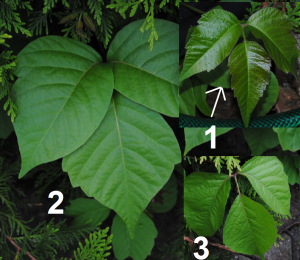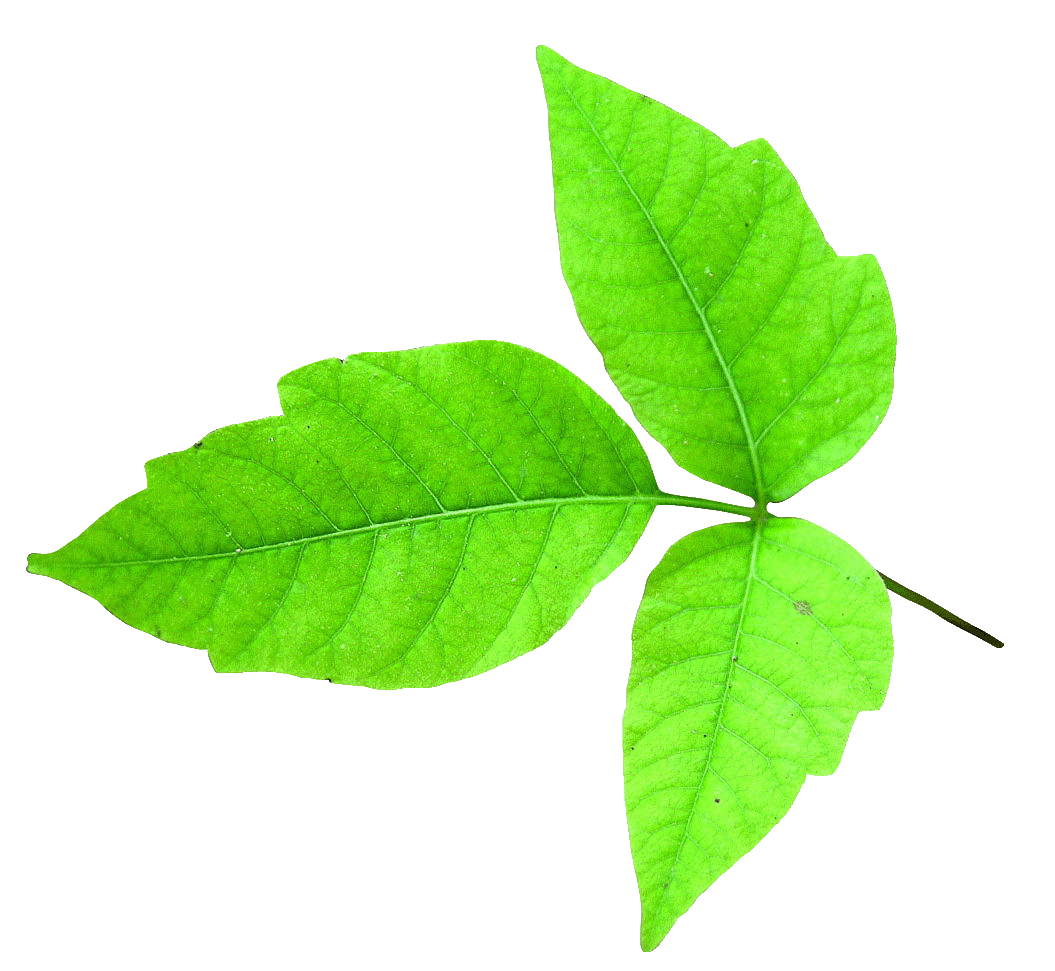Poison ivy, the plant we love to hate. How much do you know about it? Could you identify it? What makes it “poison”? What happens when you get the oil (urushiol) on you skin or clothes? How do you treat it?
The effects of poison ivy go back ages but the first published records date back to Captain John Smith in the early 1600’s. Its cousin in the west, poison oak, was used by Native Americans in California to cure warts, ringworm and even rattlesnake bites. Plants were even used in baking and dyeing. There is still speculation as to how they acquired immunity. Possibly from early exposure or just handling it very cautiously.
Urushiol is the oil that causes the poison ivy rash. It comes from urushi, the Japanese word for lacquer. It was first isolated by Rikou Majima, a japanese scientist in the first quarter of the 1900’s. Similar plants in Japan are used to create an extremely beautiful lacquer. When a poison ivy plant becomes injured it leaks urushiol which binds to your skin and causes an allergic reaction. Which means you cannot get poison ivy unless the leaf is injured.
Why are we allergic? Urushiol is not a defensive reaction of the plant, it actually helps the plant retain water. It is a compound, meaning that before it comes to the surface it is something else within the plant. When urushiol comes into contact with your skin it will start to bond and begin the reaction that causes you to itch and blister. Did you know that the first time you came into contact with poison ivy, nothing happened? That’s because the first time your body didn’t know what it was. The next time you came into contact with it your body recognized the bonding and declared it an illegal substance. Here is a simple video to explain what happens.
How many people are allergic? Around 85% of the population are allergic to urushiol but if the truth is known, most people will probably experience some degree of reaction if a sufficient quantity of urushiol is rubbed into their skin. Did you know that 50% of urushiol can be absorbed in 10 minutes and it takes very little to produce a reaction. So little that the amount on a pinhead is enough to cause rashes in 500 people.
Can I prevent it? Of course! Wear long clothing, cotton or vinyl gloves (urushiol dissolves rubber) and make sure you handle the contaminated clothing carefully. It can be washed in hot water with extra detergent for a longer period of time. There are some barrier methods out there that contain activated bentonite clay that you spread on your skin then wash off.
How do I identify it? Poison ivy spreads by roots or by berries/seeds. I’ve found plants with extensive root systems everywhere and I have found single plants. Birds and animals love to eat the berries so they also carry poison ivy into places it never was before. It can be a single plant on the ground, or a bushy overgrowth, or hairy vines climbing a tree. The plant can be light green or dark and shiny. It can be slightly red in spring but I usually see it green. Fall will turn it red and yellow. Remember, “leaves of three, let them be” always, always is accurate. There are other plants that look like poison ivy like young blackberry leaves but those have thorny stems. Poison ivy grows with 3 leaves on one stem, the leaf comes to a point but is not shaped regularly. I’ve seen the stem purplish many times. The stem of 3 leaves alternates with other stems of 3 leaves. I have never identified poison ivy by its berries which are grayish white. Below is a picture that shows how poison ivy can look.
 How do I treat the rash? If you know that you came into contact with poison ivy wash the area with soap and lukewarm water. Remember that urushiol is an oil and you can treat it as such. Don’t use hot water, it can open the pores of your skin and help it penetrate further and deeply. If the rash appears (within a few days) you can take an antihistamine for the itching. There are various kinds of antihistamines so you might want to try a benadryl with a pepsid which are two different types of antihistamines. The “second” time I got poison ivy was the worst reaction I had. I ended up having to take prednisone orally. I learned that what worked for me was taking an antihistamine called Chlortrimeton that has chlorpheniramine maleate in it. Each person is different, what works for me may not work for you. Some doctors recommend not popping the blisters because it opens your body to infection. The problem is that some of the blisters can get very large and burst on their own. And no the oozing blisters do NOT spread the oil. The rash seems to spread because it can take days to appear. Because the itching was intense I also used very hot compresses (as hot as you can take it). This tended to actually stop the itching for awhile, especially at night. I tried many natural approaches that didn’t work. You can find these on the web, my son swears by jewelweed soap. Your rash should heal within a couple of weeks. Keep it clean and treat the open blisters as you would any other wound. See your doctor if it doesn’t get better or there is an infection or it covers a lot of your body, especially the face (eyes).
How do I treat the rash? If you know that you came into contact with poison ivy wash the area with soap and lukewarm water. Remember that urushiol is an oil and you can treat it as such. Don’t use hot water, it can open the pores of your skin and help it penetrate further and deeply. If the rash appears (within a few days) you can take an antihistamine for the itching. There are various kinds of antihistamines so you might want to try a benadryl with a pepsid which are two different types of antihistamines. The “second” time I got poison ivy was the worst reaction I had. I ended up having to take prednisone orally. I learned that what worked for me was taking an antihistamine called Chlortrimeton that has chlorpheniramine maleate in it. Each person is different, what works for me may not work for you. Some doctors recommend not popping the blisters because it opens your body to infection. The problem is that some of the blisters can get very large and burst on their own. And no the oozing blisters do NOT spread the oil. The rash seems to spread because it can take days to appear. Because the itching was intense I also used very hot compresses (as hot as you can take it). This tended to actually stop the itching for awhile, especially at night. I tried many natural approaches that didn’t work. You can find these on the web, my son swears by jewelweed soap. Your rash should heal within a couple of weeks. Keep it clean and treat the open blisters as you would any other wound. See your doctor if it doesn’t get better or there is an infection or it covers a lot of your body, especially the face (eyes).
Urushiol can be good and bad. It can even be found in mangoes and cashews. It is here to stay and is getting worse. A much-cited study published in 2006 found that a rise in carbon dioxide fueled the growth of the weed and increased the potency of urushiol. Poison ivy grows everywhere, even at the edge of playgrounds and manicured lawns. So arm yourself with information (some amazing videos on the internet) to protect yourself and the children you are in charge of.
Updated August 2020


I keep getting new spots of rash, How can I discover what I touched? Or is this all from the same exposure? I an cleaning my whole room, but I don’t know, other than doorknobs, what may still have oil on it?
The spots may be from the original exposure. They continue to appear days after the first exposure. The clothes you wore are usually the culprit, they need to be washed in hot water by themselves preferably.
Probably the same as the previous reply. The skin remains sensitive for awhile, you can try something that you normally use to soothe your skin, cream such as hydrocortisone or trying regular hand cream first. Prednisone is very hard on the body so try some home remedies first then after a few weeks give your doctor a call.